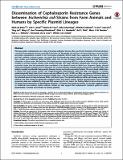Por favor, use este identificador para citar o enlazar a este item:
http://hdl.handle.net/10261/130454COMPARTIR / EXPORTAR:
 SHARE SHARE
 CORE
BASE CORE
BASE
|
|
| Visualizar otros formatos: MARC | Dublin Core | RDF | ORE | MODS | METS | DIDL | DATACITE | |

| Campo DC | Valor | Lengua/Idioma |
|---|---|---|
| dc.contributor.author | Been, Mark de | - |
| dc.contributor.author | Lanza, Val F. | - |
| dc.contributor.author | Toro, María de | - |
| dc.contributor.author | Cruz, Fernando de la | - |
| dc.date.accessioned | 2016-03-28T11:51:51Z | - |
| dc.date.available | 2016-03-28T11:51:51Z | - |
| dc.date.issued | 2014 | - |
| dc.identifier | doi: 10.1371/journal.pgen.1004776 | - |
| dc.identifier | e-issn: 1553-7404 | - |
| dc.identifier | issn: 1553-7390 | - |
| dc.identifier.citation | PLoS Genetics 10(12): e1004776 (2014) | - |
| dc.identifier.uri | http://hdl.handle.net/10261/130454 | - |
| dc.description | This is an open-access article distributed under the terms of the Creative Commons Attribution License.-- et al. | - |
| dc.description.abstract | Third-generation cephalosporins are a class of β-lactam antibiotics that are often used for the treatment of human infections caused by Gram-negative bacteria, especially Escherichia coli. Worryingly, the incidence of human infections caused by third-generation cephalosporin-resistant E. coli is increasing worldwide. Recent studies have suggested that these E. coli strains, and their antibiotic resistance genes, can spread from food-producing animals, via the food-chain, to humans. However, these studies used traditional typing methods, which may not have provided sufficient resolution to reliably assess the relatedness of these strains. We therefore used whole-genome sequencing (WGS) to study the relatedness of cephalosporin-resistant E. coli from humans, chicken meat, poultry and pigs. One strain collection included pairs of human and poultry-associated strains that had previously been considered to be identical based on Multi-Locus Sequence Typing, plasmid typing and antibiotic resistance gene sequencing. The second collection included isolates from farmers and their pigs. WGS analysis revealed considerable heterogeneity between human and poultry-associated isolates. The most closely related pairs of strains from both sources carried 1263 Single-Nucleotide Polymorphisms (SNPs) per Mbp core genome. In contrast, epidemiologically linked strains from humans and pigs differed by only 1.8 SNPs per Mbp core genome. WGS-based plasmid reconstructions revealed three distinct plasmid lineages (IncI1- and IncK-type) that carried cephalosporin resistance genes of the Extended-Spectrum Beta-Lactamase (ESBL)- and AmpC-types. The plasmid backbones within each lineage were virtually identical and were shared by genetically unrelated human and animal isolates. Plasmid reconstructions from short-read sequencing data were validated by long-read DNA sequencing for two strains. Our findings failed to demonstrate evidence for recent clonal transmission of cephalosporin-resistant E. coli strains from poultry to humans, as has been suggested based on traditional, low-resolution typing methods. Instead, our data suggest that cephalosporin resistance genes are mainly disseminated in animals and humans via distinct plasmids. | - |
| dc.description.sponsorship | This work was supported by The European Union Seventh Framework (http://ec.europa.eu/research/fp7/) Programmes ‘‘Evolution and Transfer of Antibiotic Resistance’’ (EvoTAR; FP7-HEALTH-2011-single-stage; grant number 282004; to MdB, VFL, MdT, RJLW, FdlC, and WvS), and ‘‘Plaswires’’ (FP7 ICT 2009 4; grant number 248919; to VFL, MdT, and FdlC), the Spanish Ministry of Education (http://www.mecd.gob.es/portada-mecd/) (BFU2011 26608; to VFL, MdT, and FdlC), and The Netherlands Organisation for Research and Development ZonMw (http://www.nwo.nl/) (Contract number 50-51700-98-053; to WD). | - |
| dc.publisher | Public Library of Science | - |
| dc.relation | info:eu-repo/grantAgreement/EC/FP7/282004 | - |
| dc.relation | info:eu-repo/grantAgreement/EC/FP7/612146 | - |
| dc.relation | info:eu-repo/grantAgreement/EC/FP7/248919 | - |
| dc.relation.isversionof | Publisher's version | - |
| dc.rights | openAccess | - |
| dc.title | Dissemination of cephalosporin resistance genes between Escherichia coli strains from farm animals and humans by specific plasmid lineages | - |
| dc.type | artículo | - |
| dc.identifier.doi | 10.1371/journal.pgen.1004776 | - |
| dc.relation.publisherversion | http://dx.doi.org/10.1371/journal.pgen.1004776 | - |
| dc.date.updated | 2016-03-28T11:51:51Z | - |
| dc.description.version | Peer Reviewed | - |
| dc.language.rfc3066 | eng | - |
| dc.rights.license | http://creativecommons.org/licenses/by/4.0/ | - |
| dc.contributor.funder | Ministerio de Educación, Cultura y Deporte (España) | - |
| dc.contributor.funder | Netherlands Organisation for Health Research and Development | - |
| dc.contributor.funder | European Commission | - |
| dc.relation.csic | Sí | - |
| dc.identifier.funder | http://dx.doi.org/10.13039/501100003176 | es_ES |
| dc.identifier.funder | http://dx.doi.org/10.13039/501100000780 | es_ES |
| dc.identifier.pmid | 25522320 | - |
| dc.type.coar | http://purl.org/coar/resource_type/c_6501 | es_ES |
| item.fulltext | With Fulltext | - |
| item.openairecristype | http://purl.org/coar/resource_type/c_18cf | - |
| item.cerifentitytype | Publications | - |
| item.grantfulltext | open | - |
| item.openairetype | artículo | - |
| Aparece en las colecciones: | (IBBTEC) Artículos | |
Ficheros en este ítem:
| Fichero | Descripción | Tamaño | Formato | |
|---|---|---|---|---|
| Specific Plasmid Lineages.pdf | 2,01 MB | Adobe PDF |  Visualizar/Abrir |
CORE Recommender
PubMed Central
Citations
136
checked on 24-abr-2024
SCOPUSTM
Citations
250
checked on 19-abr-2024
WEB OF SCIENCETM
Citations
239
checked on 25-feb-2024
Page view(s)
314
checked on 23-abr-2024
Download(s)
247
checked on 23-abr-2024

